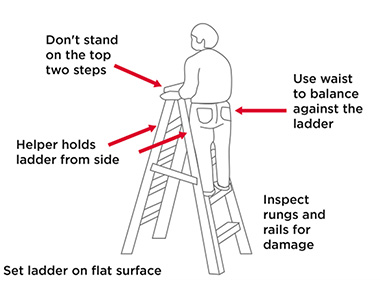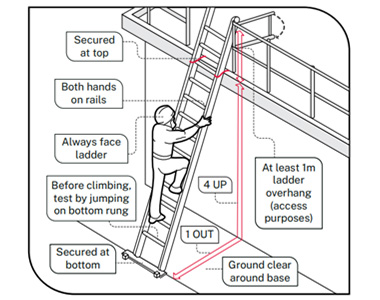Ladders
Each year there are dozens of serious incidents where workers have fallen from ladders. Most of these incidents involve a ladder being used incorrectly or inappropriately.
Safety when working on roofs
Have your say on the new code of practice for work on roofs – commercial and industrial buildings. Survey closes Sunday 14 December 2025.
Safety in the tree work industry
Have your say on the new code of practice for the tree work industry. Survey closes Sunday 7 December 2025.
Workers in construction, retail and building maintenance are most commonly injured; however any worker using a ladder is at risk.
What you can do
Only use ladders for simple access jobs, or for a short duration. It’s best to work from ground level whenever possible.
You should also consider alternatives to a ladder, such as scaffolding or an elevated work platform.
If a ladder is your only option, the following precautions can help you avoid injury.
- Choose the right ladder for the job. It should meet Australian standards and the load requirements of the job.
- An A-frame or extension ladder may be appropriate for some tasks, but a platform ladder is safer.
- Inspect the ladder for damage before each use.
- Only use a ladder if you are physically capable of doing so.
- Always set up the ladder on a flat, stable surface. If this isn’t possible then use a ladder that includes ladder safety devices like leg levellers, anti-slip gutter guards and stabilisers.
- Always maintain three points of contact when climbing or descending the ladder. This means two hands and one foot, or two feet and one hand.
- Only take small items up or down a ladder – never large or heavy items such as building materials.
- Only carry items that allow you to maintain three points of contact.
- Never lean or reach away from the ladder while using it.
- The combined weight of the person using the ladder and any items or tools should never exceed the working load limit on the ladder.
- A-frame ladders should only be used when locked in the fully-open position.
- If you’re using an extension ladder, secure it at the top, bottom or both. If this isn’t possible then have someone hold the ladder in place while in use.
- Extension ladders should be angled at a ratio of 1:4. That is, position the base of the ladder 1 metre away from the structure for every 4 metres of height.
- Do not climb or work past the second-last rung of a ladder, and never straddle the top of an A-frame ladder.
- When climbing down, remain facing the ladder and climb to the bottom rung before stepping off.


Watch this video safety alert for more tips on working safely with ladders.
Related information
- Pocket guide to ladder safety (PDF, 1104.94 KB)
- Toolbox talk: Using ladders in construction. The toolbox talk is also available in the following languages:
- Poster: Work safely at any height (PDF, 1927.38 KB)